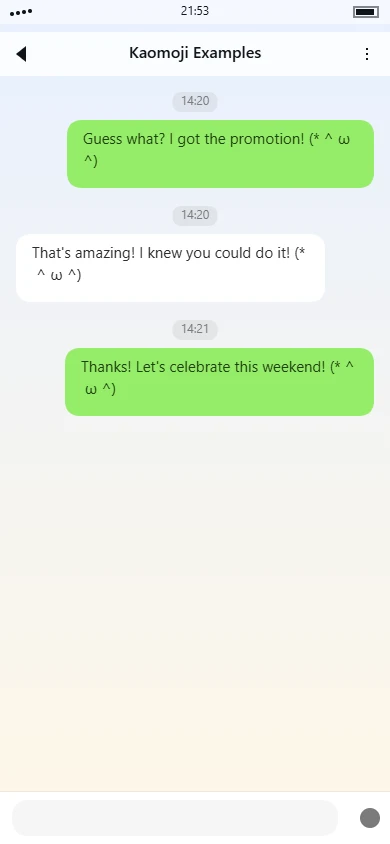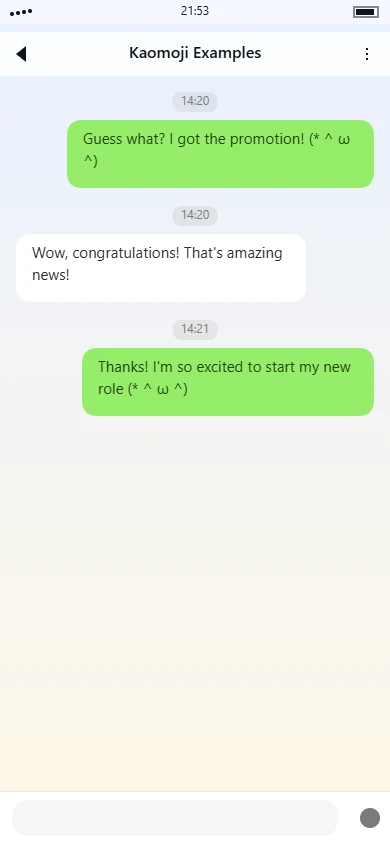(@^◡^) kaomoji meaning | usage tips

Overview
The kaomoji
(@^◡^)Symbol Breakdown
- Parentheses as face outline: The opening and closing parentheses
and(
create the basic circular shape of a face, providing a container for the facial features) - Fullwidth at symbol for cheeks: The fullwidth commercial at
serves as the left cheek, adding width and roundness to the face contour@ - Circumflex accents as eyes: Two circumflex accents
function as upward-curving eyes, suggesting a cheerful expression^^ - Smile mouth: The character
forms a distinct upward-curving mouth, completing the happy facial expression◡ - Fullwidth character consistency: All characters maintain fullwidth proportions, creating visual balance and harmony in the composition
Emotion & Aesthetic Analysis
The kaomoji conveys a straightforward happy emotion with a slightly playful quality. The puffed cheeks created by the
@(^_^)The fullwidth characters contribute to a balanced, somewhat rounded appearance that feels gentle rather than sharp or angular. The upward curves in both the eyes and mouth create visual consistency, reinforcing the positive emotional tone. This kaomoji sits in the middle range of emotional intensity—it's clearly happy but not excessively excited or exaggerated.
In practical usage, this kaomoji often appears in casual online conversations to express general contentment, agreement, or friendly acknowledgment. It works well as a response to good news or as a way to maintain a positive tone in text-based communication. The cheek elements make it slightly more expressive than basic smiley faces while remaining broadly appropriate for various casual contexts.
Tag categories
Use tags to quickly understand this kaomoji.
Usage guide
Usage Guide for (@^◡^)
This kaomoji represents a cheerful, slightly mischievous face with rosy cheeks, conveying a blend of happiness, playfulness, and lighthearted teasing. It's commonly used in casual digital communication to express positive emotions with a touch of whimsy—perfect for friendly banter, sharing good news, or reacting to amusing situations. The character's closed eyes and upward-curved mouth suggest contentment, while the '@' cheeks add a distinctive, cute flair that makes it stand out from simpler smiley faces. You'll often see it in social media comments, gaming chats, and messaging apps where users want to maintain a warm, approachable tone.
Common Use Cases
- Reacting to a friend's funny story in a group chat
- Expressing playful satisfaction after winning a game
- Responding to a compliment with humble appreciation
- Adding a cheerful tone to casual work messages with close colleagues
- Celebrating small personal achievements in social media posts
- Showing amused agreement with someone's clever observation
- Softening a light tease or joke among friends
- Expressing happy anticipation for upcoming plans
- Reacting to cute animal photos or memes
- Conveying gentle encouragement to someone sharing their progress
- Adding personality to automated messages in community servers
- Signaling friendly understanding when someone apologizes for minor mistakes
Example Conversations
-
Friend chat about weekend plans
Alex: "Just booked tickets for the concert next month!" Jamie: "No way! That's awesome (@^◡^) Can't wait to hear all about it!"
-
Gaming session coordination
Player1: "I finally beat that boss we've been stuck on for days" Player2: "Nice! Knew you could do it (@^◡^) Ready for the next level?"
-
Social media interaction
Post: "Managed to cook dinner without burning anything for once!" Comment: "Look at you becoming a master chef (@^◡^) What's the secret recipe?"
-
Workplace chat (casual context)
Colleague: "The client loved your presentation draft" You: "Thanks for letting me know! (@^◡^) I'll send the final version by EOD"
-
Reacting to shared content
Friend: "sends a video of their cat chasing its tail" You: "This made my entire week (@^◡^) Your cat is pure entertainment"
-
Planning with friends
Group: "Should we try that new café downtown tomorrow?" You: "Absolutely! (@^◡^) I've been wanting to check it out - 2pm work?"
Important Notes
- Avoid using this kaomoji in formal emails, professional reports, or serious discussions where its playful tone might undermine your message's credibility
- Be mindful that the cheeky expression could sometimes be misinterpreted as sarcasm if used in sensitive contexts or with people who don't know your communication style well
- While universally recognizable in online communities, this particular kaomoji appears more frequently in East Asian digital spaces, so consider your audience's familiarity with such expressions
- The expression works best in one-on-one or small group conversations rather than large, formal announcements where simpler emojis might be more appropriate
- Remember that cultural context matters—what reads as friendly and cute in some online circles might come across as overly casual or childish in more professional digital environments
Pro tip: This kaomoji pairs particularly well with short, positive statements and works beautifully as a reaction to good news or lighthearted content. Its distinctive cheeks make it memorable while maintaining an approachable vibe that rarely feels overwhelming or intrusive in casual conversations.
Usage examples
Real conversation samples that feature this kaomoji.

Example 1

Example 2
Related kaomoji
You might also enjoy these kaomoji.